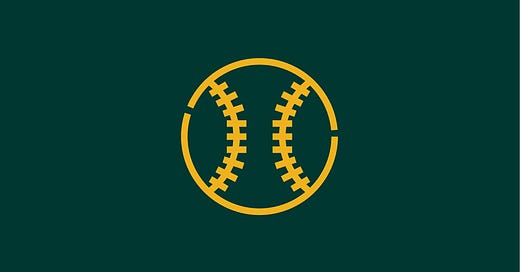Best 50 — 1974 Oakland Athletics (#21)
The A’s battle their way to a third straight championship
We’re spending the 2025 season looking back at previous seasons, specifically the 50 greatest teams in history, a group that I call the Best 50. Today’s entry, the 1974 Oakland Athletics, is No. 21 on the list, as determined by my new book, Baseball’s Best (and Worst) Teams.
Here’s a quick boilerplate explanation that I’m appending to every story in this series:
I compiled the Best 50 by analyzing 2,544 major-league teams from 1903 to 2024. Those clubs have been ranked by their team scores (TS), which are plotted on a 100-point scale. (A given club’s all-time percentile is the percentage of the other 2,543 teams that it outperformed.)
See my book for an explanation of my TS calculations. The book also offers separate breakdowns of the best and worst clubs for every decade and franchise, comprehensive profiles of the Best 50 (including position-by-position lineups and much more information than you’ll find in this newsletter), and similar summaries of the 10 worst teams of all time.
Now on to today’s profile.
Facts and figures
Team: 1974 Oakland Athletics
Team score: 88.029 points
All-time rank: 21 of 2,544
All-time percentile: 99.21%
Season record: 90-72 (.556)
Season position: First place in American League West
Final status: World champion
Season summary
The Athletics had won their second straight world title in 1973, and owner Charlie Finley unveiled their commemorative rings in March 1974. Each band featured a synthetic emerald, but lacked the traditional diamonds. “The new rings are horsemeat,” snapped pitching ace Catfish Hunter. Slugger Reggie Jackson concurred: “These are trash rings.”
But Jackson saw a silver lining. The A’s had thrived on controversy in previous seasons, and now the pot was boiling in 1974. “I predict a third world championship,” he said. “We’ve got the turmoil going already, the undercurrent.”
The turbulence extended to the manager’s office. “A man can take just so much of Finley,” snapped Dick Williams, who resigned after the ’73 World Series. Alvin Dark replaced him.
This dysfunctional atmosphere might have smothered most ballclubs. Not the A’s. Their pitchers posted the best ERA in the majors (2.95), and their hitters lofted 132 homers, second-most in the American League. Oakland surged in mid-July to a five-game lead in the AL West. That remained the margin at the end.
Baseball’s Best (and Worst) Teams
Get the complete lowdown on the 50 greatest (and 10 weakest) clubs of all time
Postseason summary
The Athletics labored through the playoffs in 1972 and 1973, winning each title in the maximum allotment of 12 games. Oakland’s opponents in both years extended the American League Championship Series and World Series to their respective limits of five and seven contests.
But 1974 was a different story. Pitchers Ken Holtzman and Vida Blue tossed a pair of shutouts in the ALCS, and the A’s dispatched the Baltimore Orioles in four games.
The World Series went just as easily. The Athletics and Dodgers split the first two games, then Oakland swept the final three. Joe Rudi’s seventh-inning homer provided the margin in Game Five’s 3-2 victory. “I’m not a home-run hitter,” said Rudi. “But there are times you have to try. This was the time.”
Subscribe — free — to Baseball’s Best (and Worst)
A new installment will arrive in your email each Tuesday and Friday morning
Lineup summary
A few players had departed since Oakland’s first title in 1972, but the lineup’s key members were still around in 1974.
Right fielder Reggie Jackson remained a primary source of power. He swatted 29 homers, second-best in the American League. Jackson also finished second in slugging average (.514). Third baseman Sal Bando was the AL’s runner-up in RBIs (103), and left fielder Joe Rudi ranked fifth in hits (174). Rudi was a rarity, a quiet man on a boisterous team. “I just try to keep my mouth shut, do my job, and keep out of people’s way,” he said.
The newcomers weren’t really new. Swift center fielder Bill North, who led the AL in 1974 with 54 stolen bases, had been acquired the previous year from the Cubs. Gene Tenace, a reserve catcher on the ’72 squad, had achieved instant stardom by blasting four homers in that year’s World Series. His only shortcoming was his inability to throw out Cincinnati’s baserunners. A reporter asked Tenace if he expected to win the MVP trophy for that series. “Even if I do,” he joked, “the Reds will steal it from me.” (Spoiler alert: Tenace won.) The solution in 1974 was to plant him on first base.
The club’s prominent starting pitchers — Catfish Hunter, Ken Holtzman, and Vida Blue — had combined for 46 victories in 1972. They boosted their total to 61 in 1974. Hunter reigned as the undisputed ace. He led the AL in wins (25) and ERA (2.49), locking down the Cy Young Award.


